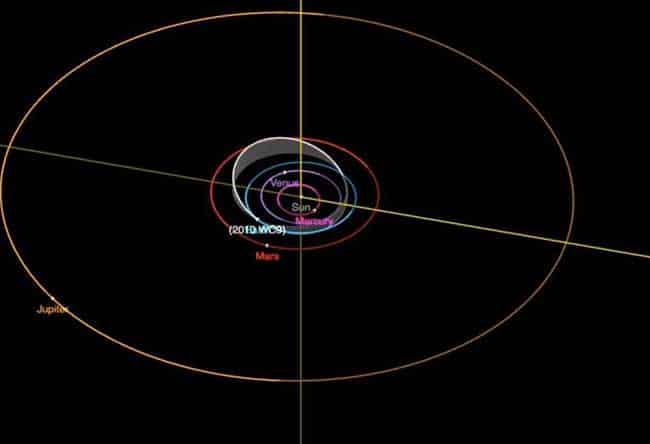
Credit: NASA/JPL-Caltech (CNEOS)
The jumbo jet-sized asteroid 2010 WC9 is approaching the earth’s neighborhood and will zoom past getting as close as 126,000 miles from us on Tuesday at speeds estimated to be approximately 29,000 miles per hour.
The asteroid 2010 WC9, affectionately known as “the lost asteroid,” at 200 to 400 feet wide, is close in size to a city block wide. It was discovered by astronomers in 2010 who were a part of the NASA-funded Catalina Sky Survey. While little was determined as to the trajectory and future encounters, enough was learned at that time to determine that it posed no threat to earth in the near future.
2010 WC9 completes one complete orbit every 1.12 years and approaches the sun as close as .78 astronomical units and as far away as 1.38 AU. (An Astronomical Unit is the distance of the earth to the sun)
While the asteroid will pass by our planet about half the distance of the earth to the moon, it will not be visible to the naked eye. But, persons wishing to see the asteroid can tune in to Slooh, the astronomy broadcasting service beginning at 4 pm Alaska time. Slooh will provide live views from four different telescopes at the Institute of Astrophysics observatory in the Canary Islands. Paul Cox and Paige Godfrey, astronomers with Slooh, will be on hand to discuss the event and answer questions from viewers. This event requires a signin and a charge of $.495. The asteroid can also be observed, weather permitting, on Northolt Branch Observatories Facebook page.
[xyz-ihs snippet=”Adsense-responsive”]Asteroids the size of 2010 WC9 collide with our planet once every 6,000 years according to astronomers, and currently, there are no known asteroids known to be on a collision course with the earth. While rocky asteroids tend to explode in the atmosphere, such as the asteroid that exploded over Chelyabinsk, if one the size of 2010 WC9 made of iron were to hit the planet, it would leave a crater the size of Meteor Crater west of Winslow, Arizona.
